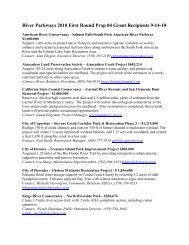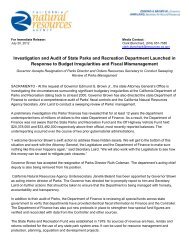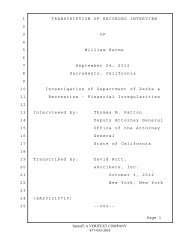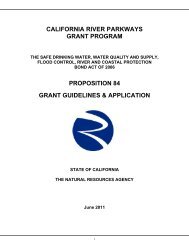California's Ocean Economy - California Resources Agency - State ...
California's Ocean Economy - California Resources Agency - State ...
California's Ocean Economy - California Resources Agency - State ...
Create successful ePaper yourself
Turn your PDF publications into a flip-book with our unique Google optimized e-Paper software.
NOEP<br />
Coastal Tourism and Recreation – More Growth/Lower Wages<br />
Coastal Tourism & Recreation dominated job growth with lower wages, while higher wage<br />
jobs in ocean-related sectors declined. This trend, which also took place nationally,<br />
represents a shift from goods-related economic activity towards services. It points to the<br />
need for <strong>California</strong> to continue to address housing and transportation issues to<br />
accommodate this workforce. In addition, <strong>California</strong> must continue its leadership efforts to<br />
protect and enhance the natural resources, which draw visitors from all over the world.<br />
Coastal Population Density Is High – More Growth Inland<br />
Not only are the oceans important economically to the state, they are much loved by the<br />
residents. In 2000, 77% of <strong>California</strong>’s population lived in coastal counties, which represent<br />
25% of the land. In fact, population density along the coast increased markedly over the<br />
decade to 671 people per square mile compared to population density for the entire state of<br />
217 people per square mile. However, between 1990 and 2000, <strong>California</strong>’s coastal<br />
population grew more slowly than the overall state population; 11.3% compared to the total<br />
state population growth of 13.7%, a difference of 2.4%. Areas of highest population growth<br />
were the inland areas immediately adjacent to the coast, where land was more available and<br />
less expensive at the time.<br />
Coastal <strong>Economy</strong>: Employment and Gross <strong>State</strong> Product<br />
Total Coastal County GSP in 2000 represented approximately 86% of <strong>California</strong>’s GSP,<br />
estimated at $1.15 Trillion. Coastal employment in <strong>California</strong> increased by 13.2% from 1990<br />
to 2000 compared to the state’s overall employment growth of approximately 12%. In 2000,<br />
total employment in coastal counties represented 81% of the state’s total employment or<br />
11,994,814 salaried workers.<br />
Regional Growth<br />
Regionally, the largest growth occurred in the central region of <strong>California</strong>, which includes<br />
Monterey, San Mateo, and Santa Cruz counties. The growth rates on all three measures,<br />
employment, wages and GSP, were larger than any other region, and were driven primarily<br />
by growth in Tourism & Recreation. The largest <strong>Ocean</strong> <strong>Economy</strong> is in the Southern, most<br />
populous region. Rural areas indicated a higher proportion of jobs relating to the coastal<br />
and ocean economy than in urban areas. The <strong>Ocean</strong> <strong>Economy</strong> represented 2.7% of<br />
employment in the highly populated Southern <strong>California</strong> economy and nearly 10% of the<br />
jobs in the northern rural region of Humboldt, Del Norte, and Mendocino counties.<br />
National <strong>Ocean</strong> Economics Program<br />
This report was funded by a Coastal Impact Assistance Program (CIAP) Grant awarded by<br />
the <strong>California</strong> <strong>Resources</strong> <strong>Agency</strong> to the National <strong>Ocean</strong> Economics Program. The NOEP<br />
team, conducting a national investigation into the ocean based economy of the United<br />
<strong>State</strong>s, has carried out this work using the most reliable available sources of information to<br />
prepare this report. The information and views expressed in this report are those of the<br />
authors and do not reflect any official views or position of the <strong>State</strong> of <strong>California</strong>.<br />
Professors Judith T. Kildow of <strong>California</strong> <strong>State</strong> University at Monterey Bay and Charles S.<br />
Colgan from the University of Southern Maine led the team.<br />
2







